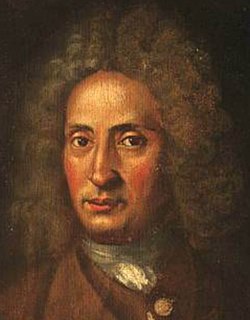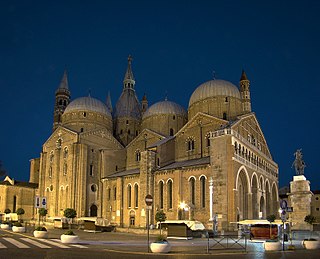Related Research Articles

Giuseppe Tartini was an Italian Baroque composer and violinist born in the Republic of Venice.

Giuseppe Torelli was an Italian violist, violinist, teacher, and composer of the late Baroque era.

Giacomo Antonio Perti was an Italian composer of the Baroque era. He was mainly active at Bologna, where he was Maestro di Cappella for sixty years. He was the teacher of Giuseppe Torelli and Giovanni Battista Martini.
The year 1699 in music involved some significant events.
AntonioVandini, a close friend of Giuseppe Tartini, was a cellist and composer. He was one of the foremost virtuoso performers of his era and spent the vast majority of his career as the first violoncellist of the ″Veneranda Arca″ at the Basilica del Santo in Padua, where Tartini was first violinist and concertmaster. Upon the death of Tartini, he returned to Bologna, the city of his birth, where he died in 1778.

Balbi may refer to:

Francesco Antonio Vallotti was an Italian composer, music theorist, and organist.
Ludovico Balbi was a Venetian singer and composer, and conductor. He was a pupil of Costanzo Porta and a choirmaster at Padua. Among his compositions are masses, motets, canzoni, madrigals, and others. Surviving compositions date as early as 1570.

The Pontifical Basilica of Saint Anthony of Padua is a Roman Catholic church and minor basilica in Padua, Veneto, Northern Italy, dedicated to St. Anthony. Although the Basilica is visited as a place of pilgrimage by people from all over the world, it is not the titular cathedral of the city, a title belonging to the Cathedral-Basilica of St. Mary of Padua. The basilica is known locally as "il Santo". It is one of the eight international shrines recognized by the Holy See.
The decade of the 1540s in music involved some significant events.

Giuseppe Maria Orlandini was an Italian baroque composer particularly known for his more than 40 operas and intermezzos. Highly regarded by music historians of his day like Francesco Saverio Quadrio, Jean-Benjamin de La Borde and Charles Burney, Orlandini, along with Vivaldi, is considered one of the major creators of the new style of opera that dominated the second decade of the 18th century.
La Passione di Gesù Cristo is the title of a libretto by Metastasio which was repeatedly set as an azione sacra or oratorio by many composers of the late baroque, Rococo and early classical period.
Giuseppe Michele Stratico was a Venetian composer and violinist of Greek descent.
Antonio Calegari was an Italian classical composer. His oratorio La risurrezione di Lazzaro 1779, was recorded under Filippo Maria Bressan in 2000.
Luigi Antonio Calegari (1780–1849) was an Italian opera composer, born in Padua. He was nephew of Antonio Calegari (1757–1828) and possibly related to other composers in the Padua Calegari family; Father Francesco Antonio Calegari (1656–1742), and Giuseppe Calegari, composer of a Betulia liberata (1771). He died in Venice.
Calegari is an Italian surname. Notable people with the surname include:
Domenico dall'Oglio was an Italian violinist and composer.
Gerolamo Frigimelica Roberti was an Italian architect, librettist, and poet.
Salvatore Fighera was an Italian composer of both sacred and secular music. Born in Gravina in Puglia, he completed his musical studies at the Conservatorio di Sant'Onofrio a Capuana in Naples and spent several years in Milan after leaving the conservatory in 1783. On his return to Naples he served as the maestro di cappella of several churches, most notably the Santuario di San Sebastiano Martire, a post he held until his death.
References
- ↑ Francesco Antonio Calegari (d. 1742): music theorist and composer Walter William Schurr - 1972
- ↑ Venetian instrumental music from Gabrieli to Vivaldi Eleanor Selfridge-Field - 1994 "Several MS copies of a treatise on consonance and dissonance by the priest Francesco Antonio Calegari survive. Calegari was maestro di cappella at the Frari in 1705 and at the Basilica del Santo in Padua in the 1720s "
- ↑ The Harvard biographical dictionary of music Don Michael Randel - 1996 "Calegari, Antonio (b. Padua, 17 Feb. 1757; d. there, 22 or 28 July 1 828)."
| | This article about an Italian composer is a stub. You can help Wikipedia by expanding it. |